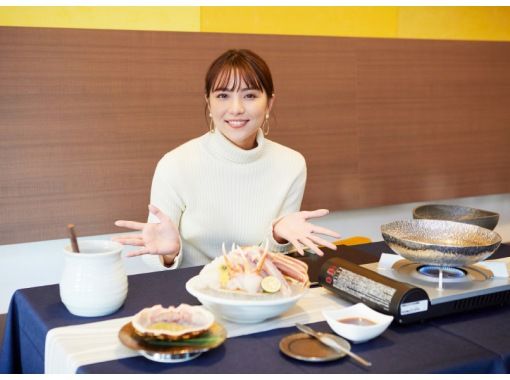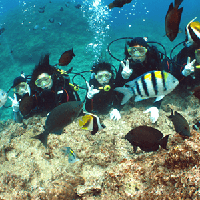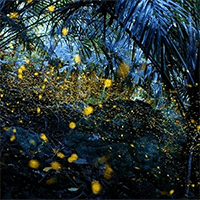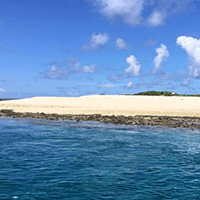- Age 16~Age 99
- 1~2 hours
- 10:00 / 14:00
The back side of the colorful color. Among the many "traditions" and "evolutions" of Nishikiyama kiln, there are many fans in the world view and charm of the work, and we pursue "Kinrande" works using gold leaf that we create independently. Kinrande kiln. The second generation owner, Minori Yoshita, is widely known as a living national treasure of Kutani ware. In this program, you can see the inquisitive spirit transmitted to the Nishikiyama kiln and experience a part of it in order to demonstrate the creativity that can be said to be a transcendental technique that looks very profane. Nishikiyama kiln with a history of over 100 years. In addition to traditional techniques, we are also working on new things in the face of the big question, "How will we deliver it in the next 100 years?" We will review traditional techniques, search for a way that is suitable for our current life, and train the staff of the kiln. Nishikiyama kiln manufacturing aims to integrate tradition and innovation. "Kinrande" Kinrande refers to the decorative technique of fixing gold on colored ceramics and its works. Beginning with the Song dynasty in China, it flourished from the Ming dynasty to the Qing dynasty. In Japan, the Kinrande appeared from the Genroku era of Edo, using the Ming dynasty's Jingde Town kiln as an example, and it resembled the "Kinrande" woven fabric woven with gold thread and cut gold leaf, so it came to be called by this name in Japan. rice field. There are techniques such as "drawing gold" to draw a line with gold paint, "swinging gold" to scatter gold powder, and "pasting gold" to paste gold leaf. * For foreign nationals: Information on the day will be in Japanese only.
- Age 13~Age 99
- 1~2 hours
- 10:00 / 14:00
The back side of the colorful color. Among the many "traditions" and "evolutions" of Nishikiyama kiln, there are many fans in the world view and charm of the work, and we pursue "Kinrande" works using gold leaf that we create independently. Kinrande kiln. The second generation owner, Minori Yoshita, is widely known as a living national treasure of Kutani ware. In this program, you can see the inquisitive spirit transmitted to the Nishikiyama kiln and experience a part of it in order to demonstrate the creativity that can be said to be a transcendental technique that looks very profane. Nishikiyama kiln with a history of over 100 years. In addition to traditional techniques, we are also working on new things in the face of the big question, "How will we deliver it in the next 100 years?" We will review traditional techniques, search for a way that is suitable for our current life, and train the staff of the kiln. Nishikiyama kiln manufacturing aims to integrate tradition and innovation. "Kinrande" Kinrande refers to the decorative technique of fixing gold on colored ceramics and its works. Beginning with the Song dynasty in China, it flourished from the Ming dynasty to the Qing dynasty. In Japan, the Kinrande appeared from the Genroku era of Edo, using the Ming dynasty's Jingde Town kiln as an example, and it resembled the "Kinrande" woven fabric woven with gold thread and cut gold leaf, so it came to be called by this name in Japan. rice field. There are techniques such as "drawing gold" to draw a line with gold paint, "swinging gold" to scatter gold powder, and "pasting gold" to paste gold leaf. * For foreign nationals: Information on the day will be in Japanese only.
- Age 1~Age 99
- Within 1 hour
- 10:30 / 11:30 / 13:30 / 14:30 / 15:30
Recommended for those who are interested in the production process, molding method, and on-site production of Kutani ware! ! We use a variety of Kutani ware molding methods that can only be found at kilns for mass production. We will demonstrate and explain in front of you while keeping a safe distance, so you can participate with confidence. Suitable for small groups or groups. *For groups (10 or more people), please contact us directly. ~ Flow of the day ~ 9:50 Meeting and reception Explanation of Miyayoshi Ceramics 10:00 Site tour (30 minutes) / ② 11:00 ~ ③ 13:30 ~ ④ 14:30 ~ ⑤ 15:30 ~ A wide variety of things such as pottery wheel and casting etc. Tour of the base manufacturing site *After the tour, stop by a souvenir shop and leave. For those who don't want to go home empty-handed after a tour, we will introduce you to the souvenir shop of our kiln, where we have a large selection of pottery that can only be purchased at the kiln.
- Age 4~Age 70
- 1~2 hours
- 11:00
Mikuni Port is one of the leading fishing ports in Fukui Prefecture. Using a whole yellow-tagged Echizen crab purchased from the Mikuni Port Market, you can make the legendary crab dish "Original Crab Miso Shabu" that we have been serving for over half a century! "Crab Miso Shabu" is our most popular crab dish, where you eat crab sashimi with a plump texture by shabu-shabu. You can also learn about the ecology of Echizen crab, and the instructor will carefully lecture you on how to fillet the crab, so even beginners can participate with confidence! In addition, a crab peeler will be used, so even children can experience it safely. Once you are done, enjoy the delicious taste at the restaurant attached to the facility! The deliciousness of the "Crab Miso Shabu" you made yourself is exceptional. ★Flow of the experience day [STEP 1] 10:50-11:00 (about 10 minutes) Please gather 10 minutes before the event time and complete the reception. [STEP 2] 11:00-11:10 (approx. 10 mins) Guidance begins [STEP 3] 11:10-12:00 (approx. 50 mins) Crab miso shabu-shabu making experience begins! [STEP 4] 12:00-13:00 (approx. 60 mins) Enjoy the food at the attached restaurant! <Notes when applying> The price of this plan varies depending on the number of crabs used. ●If there are two participants and one Echizen crab is used 22,000 yen x 1 crab = 22,000 yen ●If there are two participants and two Echizen crabs are used 22,000 yen x 2 crabs = 44,000 yen
- Age 4~Age 70
- 1~2 hours
- 10:00
Sweet shrimp is as popular as Echizen crab in Fukui Prefecture. You can make the ultimate sweet shrimp rice bowl using brand sweet shrimp and the legendary gasa shrimp purchased from Mikuni Port Market, which boasts the highest catch in the prefecture! The instructor will carefully support you from how to peel the shrimp to plating. You can also have fun learning trivia about sweet shrimp and gasa shrimp. Arrange the shrimp to your liking on top of rice made with Koshihikari rice from Fukui Prefecture, and your original sweet shrimp rice bowl is ready! Once it's complete, you can enjoy it at the restaurant attached to the facility! The rice bowl you made yourself is exceptionally delicious! Since you don't need to use a knife, even small children and those who are not good at cooking can enjoy the experience! There are several different ways to plate the food, so you can enjoy different ways to plate the food each time you participate. ★The flow of the experience day [STEP 1] 10:00-10:15 (about 15 minutes) Guidance begins [STEP 2] 10:15-11:00 (about 45 minutes) Amagasa rice bowl making experience begins! [STEP 3] 11:00-11:30 (about 30 minutes) Taste it at the restaurant attached to the facility!
- Age 4~Age 70
- 1~2 hours
- 10:00
Mikuni Port is considered one of the leading fishing ports in Fukui Prefecture. You can experience making your own ultimate crab bowl using two whole female Echizen crabs, Seiko crabs, purchased from Mikuni Port Market. You can enjoy the experience with the instructor while listening to lectures such as explanations of the parts and how to peel them. Since special crab scissors are used and no knives are used, even beginners and children can participate with confidence. Arrange to your liking on top of rice made with Koshihikari rice grown in Fukui Prefecture, and your original crab bowl is ready! Once completed, enjoy the crab bowl you made at the attached restaurant. The taste of the rice bowl you made yourself is exceptional! ★Procedure on the day of the experience [STEP 1] 9:50-10:00 (approximately 10 minutes) Please gather 10 minutes before the event time and complete the registration. [STEP 2] 10:00-10:05 (about 5 minutes) Guidance starts [STEP 3] 10:05-11:00 (about 55 minutes) Crab bowl making experience starts! [STEP 4] 11:00-11:45 (about 45 minutes) Let's eat at the attached restaurant!
- Age 12~Age 99
- 4~5 hours
- 09:50
<Points of this plan> ・ Full-scale cooking experience using local seasonal ingredients based on local cooking research ・ A certified guide will guide you to spots where you can feel local life such as shrines and markets. ・ Walk in a local back alley full of life that is not often used for sightseeing First, head to IN KANAZAWA HOUSE through a narrow alley full of life, with a glimpse of the everyday life of the locals. IN KANAZAWA HOUSE is a traditional Kanazawa Machiya-style building where you can feel the lifestyle of those days. The traditional townhouse has a large, renovated kitchen where you can experience cooking home-cooked meals. A cooking researcher born in Kanazawa will teach you special recipes using seasonal ingredients. The cooking process will be explained with demonstrations such as how to make soup stock, and home-cooked dishes will be handed down locally. When it's done, it's finally a fun meal. After a meal, take a photo at the townhouse, explore, relax while looking at the garden, and relax. 《Weekly menu》 Sushi course Oshizushi (Ishikawa's specialty), omelet, boiled plum shellfish, 1 local dish (4 dishes in total) Tempura course Tempura using seasonal seafood and vegetables, omelet, soup, local dish (4 items in total), rice ~ Flow of the day ~ 9:50 Kanazawa Station East Exit Tourist Information Center "Hyakuman-san" Meeting / Check-in 10:00 Walk from Kanazawa Station (about 1km) An English tourist guide will guide you. Cooking experience of home cooking at IN KANAZAWA HOUSE 14:00 Dissolution in front of Kanazawa Station
最近チェックしたプラン
Please wait a moment
![[GEMBA Monozukuri Expo 2023] Immerse yourself in the world of beautiful glazed gold colors created by living national treasures with a gallery tour and brocade experienceの画像](https://img.activityjapan.com/10/51016/10000005101601_X9MeawNo_3.jpg?version=1695888317)
![[Ishikawa/Komatsu City] KUTANism 2023 Workshop Tour: Immerse yourself in the beautiful world of glazed gold color created by a Living National Treasure, gallery tour and Kinrande experienceの画像](https://img.activityjapan.com/10/50978/10000005097801_X9MeawNo_3.jpg?version=1695703882)
![[Ishikawa/Komatsu City] KUTANism 2023 workshop tour: Let's enter! Kutani ware kiln tour course♪の画像](https://img.activityjapan.com/10/50972/10000005097201_Bwe3oL1b_3.jpg?version=1695702859)

![[Only available in October] "The ultimate sweet shrimp rice bowl making experience" / The only event near Mikuni Port Market, the home of Fukui sweet shrimp!の画像](https://img.activityjapan.com/10/46351/10000004635101_QFZSiu2d_3.jpg?version=1719808922)

![[Ishikawa / Kanazawa] Experience local cooking in Kanazawa and experience local life at the local back alley "Market"の画像](https://img.activityjapan.com/10/35783/10000003578301_mBDQW4j9_3.jpg?version=1612754910)







